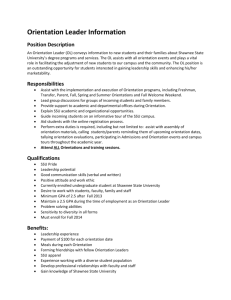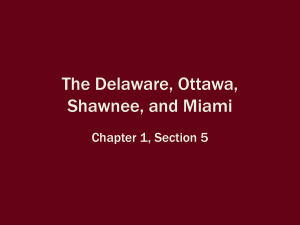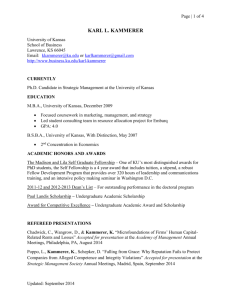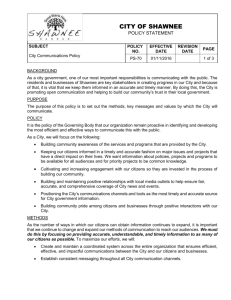CCM10072014 - City of Shawnee
advertisement
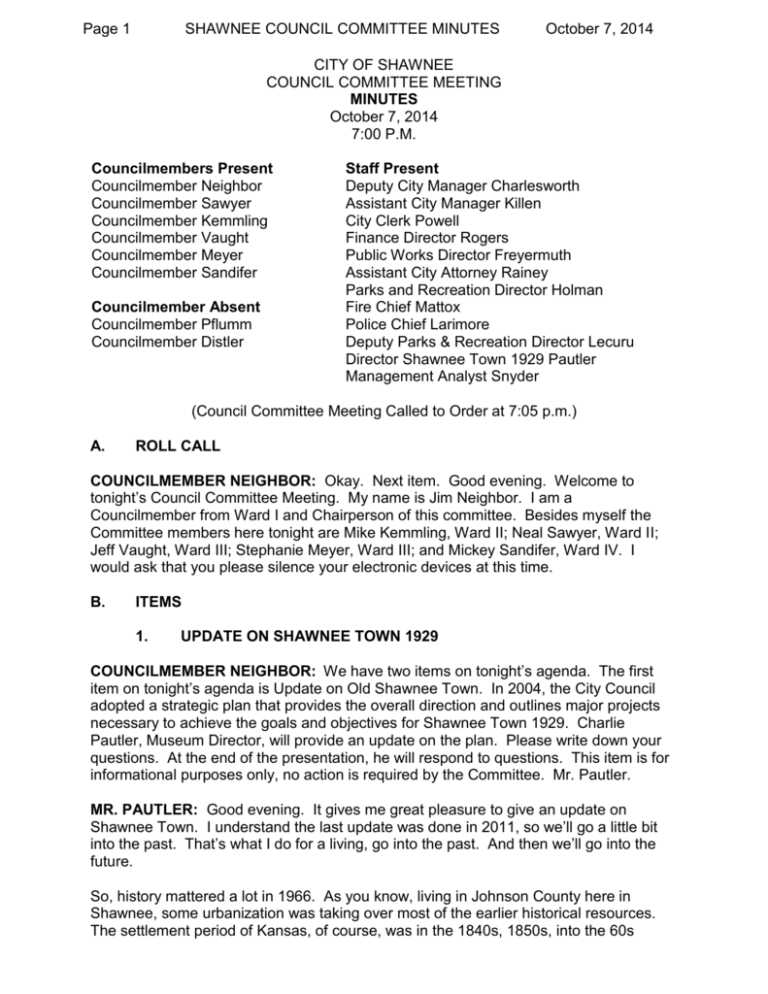
Page 1 SHAWNEE COUNCIL COMMITTEE MINUTES October 7, 2014 CITY OF SHAWNEE COUNCIL COMMITTEE MEETING MINUTES October 7, 2014 7:00 P.M. Councilmembers Present Councilmember Neighbor Councilmember Sawyer Councilmember Kemmling Councilmember Vaught Councilmember Meyer Councilmember Sandifer Councilmember Absent Councilmember Pflumm Councilmember Distler Staff Present Deputy City Manager Charlesworth Assistant City Manager Killen City Clerk Powell Finance Director Rogers Public Works Director Freyermuth Assistant City Attorney Rainey Parks and Recreation Director Holman Fire Chief Mattox Police Chief Larimore Deputy Parks & Recreation Director Lecuru Director Shawnee Town 1929 Pautler Management Analyst Snyder (Council Committee Meeting Called to Order at 7:05 p.m.) A. ROLL CALL COUNCILMEMBER NEIGHBOR: Okay. Next item. Good evening. Welcome to tonight’s Council Committee Meeting. My name is Jim Neighbor. I am a Councilmember from Ward I and Chairperson of this committee. Besides myself the Committee members here tonight are Mike Kemmling, Ward II; Neal Sawyer, Ward II; Jeff Vaught, Ward III; Stephanie Meyer, Ward III; and Mickey Sandifer, Ward IV. I would ask that you please silence your electronic devices at this time. B. ITEMS 1. UPDATE ON SHAWNEE TOWN 1929 COUNCILMEMBER NEIGHBOR: We have two items on tonight’s agenda. The first item on tonight’s agenda is Update on Old Shawnee Town. In 2004, the City Council adopted a strategic plan that provides the overall direction and outlines major projects necessary to achieve the goals and objectives for Shawnee Town 1929. Charlie Pautler, Museum Director, will provide an update on the plan. Please write down your questions. At the end of the presentation, he will respond to questions. This item is for informational purposes only, no action is required by the Committee. Mr. Pautler. MR. PAUTLER: Good evening. It gives me great pleasure to give an update on Shawnee Town. I understand the last update was done in 2011, so we’ll go a little bit into the past. That’s what I do for a living, go into the past. And then we’ll go into the future. So, history mattered a lot in 1966. As you know, living in Johnson County here in Shawnee, some urbanization was taking over most of the earlier historical resources. The settlement period of Kansas, of course, was in the 1840s, 1850s, into the 60s Page 2 SHAWNEE COUNCIL COMMITTEE MINUTES October 7, 2014 before statehood in 1861. So, a lot of these first buildings, like the one shown here, this is our stone building, which is now at Shawnee Town, it was the first building that was brought into the park. It was under threat, as many buildings were in the United States all over, because suburbs were popping up, new businesses were popping up, shopping malls. And so on the national scene, the National Historic Preservation Act was passed that year and locally the Shawnee Historical Society was formed. A group of concerned citizens, a grassroots effort, and they got together and saved this building. It was the second building that they tried to save. The first one was not saved. That was the old wagon master’s house, and that was attempted in 1959. But the good news is they were able to save this one. It was brought to Bluejacket Park, which was a county park at that time. But it was saved. It was understood for many years that it was the first territorial jail. And through research, I brought a lot of research with me tonight that we’ve conducted, and in the next 50 years almost we realized that it was not the first territorial jail. It was simply -- it was a house, it was a business. It was a store at one time and then finally a furniture store/warehouse. So, that’s the building that started it all. Flash forwarding ten years to 1976, by that time the bandstand had been built. The stone building that I showed you in the previous slide is in the lower left corner. By that time we erected some historical reconstructions of what we thought were pretty accurately done. And as you can tell looking out towards Johnson Drive there is where a Town Hall would be now. But even that wasn’t built yet. Town Hall was built in 1982. So, Town Hall went right here in 1982. But the Hart Home, which I’ll show you in just a few minutes went in in 1976. The Visitors Center, which is what we have now, it was actually a trading post for a while. And then this block of buildings was built in 1967. But moving fast forward, the museum needed focus, it needed direction. They did some great things though in those early year, they preserved buildings. They preserved our cultural resources for us today. But by 1998 into -- from 1998 to 2002, it was transferred ownership over to the City. So, the Shawnee Historical Society became our Friends group, they’re Friends of Shawnee Town. And by 2002, the City realized that we needed a strategic plan in order to progress into the modern day. And what would we do? What are we going to interpret? What service are we going to provide for our citizens of Shawnee? So, the Mayor and City Council -- the Mayor appointed a committee to draft the strategic plan. It was made up of the City Council, the Shawnee Historical Society, the civic and business community, museum and other City staff and a huge plethora of volunteers. So in addition to that, focus groups were created, comprised of local historians, a lot of teachers, educators to help us figure out what we wanted to do with Old Shawnee Town. So the goals of the committee, they were pretty simple. Provide opportunities for visitors to learn what life was like in the City of Shawnee through historically-accurate research-based programs that offer memorable evocative experiences in a unique setting. The second goal, broaden Shawnee Town’s base of support in the community to serve a greater number of visitors in a meaningful way each year. And the mission of the museum is an active, fun place where visitors of all ages learn what it was like to live in Shawnee, Kansas in the 1920s. We engage in thoughtful tours, exhibits, and programs which allow visitors to experience a typical day in and around the City of Shawnee. Page 3 SHAWNEE COUNCIL COMMITTEE MINUTES October 7, 2014 So, why the 1920s? You got wing-walkers. You got people doing the Charleston. Pretty cool. But there’s a lot more to that. There’s a reason why we chose the 1920s and why we zero in on 1929 specifically. The City of Shawnee was incorporated in the 1920s, back in 1922. It was a farm town supported by a rural cash economy. It served as the primary link to the Kansas City Market. Shawnee was one of the biggest providers of fruits and vegetables to the Kansas City Market then and through about the 1940s. The Mission Theater opened in 1927 of that year showing silent films. The Jazz Age was the 20s. The radio, a big era, the first big era of sports and national Prohibition all came to Shawnee in the 1920s. In 1929, we had a weekly newspaper, the Northeast Johnson County Herald. And they had a special section on Shawnee where they reported on the comings and goings, what was happening in Shawnee, every week. So, we have a really good written primary source record of what was going on in that year. And of course, 1929 was the watershed moment in our U.S. history. That was beginning of the Great Depression. So, it affected us nationally, locally, regionally and it had state impacts. Stock market crash. And although the immediate worst part of the depression didn’t come to Shawnee for a couple years, it was a watershed year. It was the last full year of the inner-urban trolley line. And that was a trolley line that ran from Kansas City to Shawnee, and it represents a time period -- we’re all from this area. It represents a time period -- you know the Kansas City museums, it’s very heavy on Civil War area, the border war conflict. It offers us a unique niche in the museum community and in the education community. So, going over some of the numbers. Our funding sources and expenditures, we get two main funding sources for the construction and the maintenance of Shawnee Town. The Liquor Tax, and these are for the last six years a combination of those, 779,000, and the Ron Deffenbaugh Foundation has contributed 500,000 for the building of our farmstead. Our expenditures match our revenue. We run on a balanced budget. Our other revenue, we also get -- we have a very prolific Friends group, the Friends of Shawnee Town and they have big fundraisers for us each year through our special events. And they over the last six years, they have given us $57,000 mainly for furnishings. Everything from plates to bowls to rugs to drapes to tables and furniture. They pay for that. The City does not pay for that. It’s our Friends group. That if we need to go buy something we use those funds or we also get things through donations. The Johnson County Heritage Trust Fund has been very generous to us over the last six years in the tune of $86,000. We usually get about two grants per year from them, one for our Friends group and one for the City. The Thompson Family and the Cohen Family, who are generous, they have purchased -- they have given us money so that we could purchase furnishings for our historical restoration projects. As part of the strategic plan, they laid out various phases of work. So, I through IV is what we’re working on. Phase I, I’m happy to report, is completed. We finished it last May of 2013. And that was everything having to do with the Farmstead. The research, I brought just some examples of the research. Research is the first phase that historians do when we’re reconstructing a place like Shawnee Town. So, here is the stone building. We found a researcher that was able to dig up all the information that told it wasn’t the first territorial bank. So, I just brought examples. The Typewriter Shop, the Barber Shop, the Funeral Home business and Garrett & Sons’ Groceries. So, just a few if anybody would like to take a look at those, you certainly can. But research is the first phase. We spent many years researching archives all over the Kansas City area, the Kansas City State Museum, Missouri State Museum, Johnson County Museum and various other archives, the National Archives. Page 4 SHAWNEE COUNCIL COMMITTEE MINUTES October 7, 2014 So, the Farmstead, this is what we envisioned back in about 2006, what it would look like. The heart of the, no pun intended, the heart of the Farmstead is the Hart-DeCaeny Home. Originally at 75th and Quivira. And this was just a four -- a two over two-room house with a central hallway and then a kitchen frame addition on the back. And it has kind of an interesting history since it’s been at Shawnee Town. It was moved here in 1976. During the move the kitchen addition, which is on the front here, that fell off of the truck. So, we elected to reconstruct that kitchen when we redid the restoration. So, this is the interior of the kitchen, of the farmhouse. The bedroom, the front room or the living room, what we call it today, where you would bring people to entertain them in that little off time that you had, and then the kitchen. And we have interviewed a lot of Belgium immigrants, German immigrants, people that grew up here in Shawnee. We interviewed them back in the 1990s and early 2000s when they were still living, so we have a lot of first-hand accounts on what these people did, what they did for a living, what they cooked, what they ate, how they worked. So, this is Belgium raisin bread. I’m sorry I didn’t bring samples tonight. We also have many other original buildings that were brought in during various phases of Shawnee Town’s history. This is a livestock barn. Just a small barn for two horses that would have been your draft horses, and then a milk cow. A smokehouse, which is an original building. We will be using it this November for a meat processing program. Chicken house and then the outhouse next to it, those came from the same farm west of here. Then we have reconstructed buildings. COUNCILMEMBER SANDIFER: Are you smoking chickens? MR. PAUTLER: No, we’re processing a hog. Under Neil Holman’s direction no chickens will be harmed. We do use the chickens though for eggs. We do sell the eggs in our gift shop. More about the chickens in a moment. This is a reconstructed building, the tool shed. Every farm had one. A garage. This is a reconstructed building as well. When I say reconstructed, I mean it’s a new-made building in the old style. And then we have a 1927 Nash that our Friends group bought for us and they gifted to us. Because the Caeny family that bought the home in 1926 from the Hart family, they had a 1927 Nash. So, we were able track one down. And then the Market Shed would have been the most modern on a truck farm. And this is probably a good opportunity to talk about the farming in Shawnee. Most of the farmers were truck farmers. They weren’t big farmers like out in Central and Western Kansas. These were people that grew vegetables and fruits and they trucked them literally into the Kansas City Market and that’s how it gets its name. So, this would have been the most modern building. You would have had running water in here. You would have had lots of room. The bay on the left where we keep the wagon, there is a big open area where they would have spread out tables and cleaned the produced, packaged the produce, brought it around to the loading dock on the right side, and that’s our Ford Model AA. AA just stands for heavy duty pickup truck. And that once belonged to Mickey Sandifer. But it’s gone through a lineage of people and it ended up with us. We’re very happy to have it. It was fully restored. It was a ground off restoration done by our Park Maintenance crew. So, they did an expert job on it. It’s won some awards at the Shawnee Car Show. We’re very proud of it. Root Cellar. What would a Kansas farm be without a root cellar? It pulls double duty, keeping root crops down in there over the winter and then also serves as a storm shelter. Page 5 SHAWNEE COUNCIL COMMITTEE MINUTES October 7, 2014 But what would these buildings be without people and without programs? So, these buildings would just be a shell. They would just be interesting things to look at and say, oh, that’s nice. But what is nice? Nice doesn’t bring relevance to your lives. So, we want to show what these people lived like, how they lived, what was important to them, how they got by, how they made their living, what their values were. So, that’s what a museum is put on earth to do is to draw relevance. Otherwise, museums wouldn’t be worth anything. So, we want to show you what -- how your past ancestors make your lives relevant today. So, we have an avid living history program, very active. Really in two areas we have developed programs over the last three years. In our school programs, which you see some photos here, we have school groups from Topeka. We have school groups from Lee’s Summit that come from Kansas and Missouri and those numbers have increased slightly over the years. School groups are a tough group to crack though, because schools are going through -- usually going through budget cuts. And one of the first things that principals and PTAs trim are field trips. So, we have to be really innovative in the programs that you create. And the way that we’ve done that, we make ourselves -- we try to make ourselves much more necessary than a school group maybe from ten years ago. We base our programs and curriculum, especially in Social Studies for the younger groups, history for the older groups and some math and science and especially reading thrown in, so that teachers can justify when they are asking for funding for their PTA and asking for funding from their principals that they can get a unit taught that’s part of their curriculum out at Shawnee Town Museum. That’s how we’re able to get kids out there these days. Twenty years ago when I got out of grad school it wasn’t a problem. We never had to talk about relevance. You know, you’d just open your doors and people would come, because it’s an interesting museum. Now we have budget cuts and now we have so many other competing factors for our leisure time. So, you have to really make yourselves much more relevant. So, our school attendance, we’re up to about 1,500 people this year. And that’s just from last month. Our total attendance, as you can tell from our numbers, we’re very dependent on Old Shawnee Days. That’s our biggest public event. We have mission-based programs and we have community-based programs. In our community-based programs, Shawnee Town Museum offers a nice, safe gathering place for families to have wholesome experiences. So, this year our attendance -- last year it was 141,000. Our revenue in 2013, and most of this is through our gate fee, special programs fee, but mostly our rentals through Town Hall program. Our revenue in 2013 was $113,000. So, right now we’re on target for about 113 to 114,000 for 2014. As I said, we base our programs on current school curriculums. And when the schools - when the states change their curriculums we have to change our programs. So, we try and follow those as closely as we can. In the Market Shed on the left they’re cleaning asparagus and packaging it. On the right they’re in the kitchen seeing how a stove works. And the chickens. The chickens are probably our most famous stars at Shawnee Town Museum. We’re very lucky interpreting a museum in the 1920s and the fact that if we were interpreting the 1840s, we would have much less written material, original material out there to look at, to have access to. We’re very lucky, because Kansas State University has always been putting Page 6 SHAWNEE COUNCIL COMMITTEE MINUTES October 7, 2014 out agricultural bulletins and journals. They’re the State’s agricultural school. So, in 1928, for example, they put out a poultry bulletin that tells us all the top breeds of chickens that were grown in Johnson County. So, we know that, you know, what we’re growing out there we can track down the right breeds today so that when visitors come out they’re actually looking at an historic breed instead of something that you just buy. So, they produce beautiful greenish-brownish eggs that our visitors like to buy. But the centerpiece of a truck farm, of course, is the truck garden. And everything that we have planted in it is a 1929 variety or earlier that was popular in this area as far as we can research it. We have red okra in the foreground there. We have asparagus in the very back. You have to wait three years to harvest that. Next year is our year. So, we’ll be harvesting that in May. That’s our stand of corn this year. We had a really nice stand of -- it’s a Dent corn that we grow that was introduced in 1893 and was real popular here. And there’s our 1920s people again. So, the Cityscape is really the next phase, and that’s what we’ve been working on in tandem alongside -- while we’ve been working on the Farmstead, which was completed in ‘13, we also started the Cityscape. And we have several buildings finished there. Here is the buildings that have been completed so far, Liestman’s Ice House. And that’s an original photo from 1929. Here is our reconstruction. The reconstructed Yotz Typewriter Shop. This is a gentleman that had a mail order typewriter repair business. He did not court local business. He advertised in farm journals and ladies magazines. So, people would mail him their broken machines and he would fix them and mail them off. He was a part-time policeman. He was a real estate magnate, a World War I veteran. So, he had his iron in many different fires. The Bouseman Barber Shop. eBay is a wonderful thing. We can find -- source many of our hard to find objects on eBay on the Internet. There is Neal Sawyer getting a straight shave back in July. We had a grand opening for our Barber Shop this summer and we had a barbershop quartet that came in. It was a lot of fun. The City Jail. As you can tell crime was fairly small. This jail was -- the original jail was built in 1926, and that’s what the interior looks like, just one holding cell. We had about a quarter time police officer, and that was Mr. Yotz. COUNCILMEMBER SANDIFER: Is that the cell that was in the other jail? MR. PAUTLER: Yes. COUNCILMEMBER SANDIFER: Thought so. MR. PAUTLER: And there were only two ways that people were taken to jail back then. One was because of Prohibition, violating Prohibition, either consuming or distributing alcohol, and also speeding tickets. So, excessive speed got you in the jail. Garrett’s Grocery Store. We have physically finished the outside. We have not installed any artifacts yet. Our goal is this June, by Old Shawnee Days of 2015, we would like to have that outfitted. There it is today. Undertaker building. Undertaking was a science by the 1920s. It was also undertaking and furniture as you see in this slightly earlier photo. It was a science that you went to -- it was a profession you went to school for by the 1920s. And there it is today. Again, it’s empty as well. We would like to get it furnished. We were able to get three key significant collections over the last two years for this. One was the [inaudible] family. It was a collection that we already Page 7 SHAWNEE COUNCIL COMMITTEE MINUTES October 7, 2014 had that was donated back, starting in the 70s. And then we were able to get two other Kansas-based collections donated to us since 2012. And those will be featured in this building. COUNCILMEMBER SANDIFER: Was that Paul’s at that period of time? MR. PAUTLER: I’m sorry? COUNCILMEMBER SANDIFER: Was that Paul’s funeral home at that period of time? MR. PAUTLER: Bassler was the undertaker in town. COUNCILMEMBER SANDIFER: Bassler. MR. PAUTLER: His name was Bassler. So, the buildings along the north block that we have not constructed yet that we are -- we have researched and we have the building reports in. We’re working on the interpretative reports on these four buildings, the Shawnee State Bank, Goddard’s Electric Store. And I want to show you what an electric store would have looked like. You may wonder what’s an electric store. Well, any electrical appliance and these were fairly new technology in 1929. You went there to buy anything from a toaster to a vacuum cleaner, hair dryer. So, that’s an electric store. It’s going to be a fairly complex building, too. COUNCILMEMBER SANDIFER: You could still tear down that original bank over here if you need to put it in there. MR. PAUTLER: Okay. COUNCILMEMBER SANDIFER: Clear that corner out for us. MR. PAUTLER: Okay. Well, we’ll see what we can do. I can’t make any promises. COUNCILMEMBER SANDIFER: It’s still inside there, isn’t it? Isn’t the original walls still inside? MR. PAUTLER: I believe they are, yeah. Tom Davis Dry Goods Store. The gas station and fire department. There was no separate fire department. They didn’t have their own building yet. So, they were -- their fire engine, the City of Shawnee fire engine was parked in the gas station bay. And Fisher’s Chevrolet. This photo is a bit misleading, because they were having their 50th anniversary when that photo was taken, so they had their horseless carriage out front to show people. But that’s what Fisher’s looked like in the -- what the building looked like in the 1950s. We couldn’t do what we do without all of our partners. And the Shawnee Mayor and City Council, of course, the City of Shawnee staff. We depend on every department within the City to help us, from finance to information technology, public information, marketing, the City Manager. Carol has been very good. Vicki has been very good. Police, Fire, they help us with all of our special events. And the Planning Department, they help with special events, too. City of Shawnee Parks and Recreation Department, they help manage all of the construction projects. They help set up and tear down for all of our special events. Anytime -- and we are part of the Parks and Recreation Page 8 SHAWNEE COUNCIL COMMITTEE MINUTES October 7, 2014 Department. I’d like to make that clear, but they’re a very active partner with us. We see them every day. The Friends of Shawnee Town. They are our support group as I mentioned earlier. They’ve given us several thousand dollars that they’ve raised through special events at our site. Local businesses, they sponsor a lot of our events. Our Christmas event coming up, our Halloween event coming up. The Chamber, the Convention and Visitors Bureau. Kevin Fern has been very active promoting us, getting support for us. And lastly, but not least, the dedicated core of volunteers. We have a huge pool of volunteers that we work. Some of them are City volunteers. Some of them are our own. Everything from living history interpreters to special event volunteers. So, they all help us. And not just our volunteers that work the museum, but our volunteer boards, our Parks board, Old Shawnee Days committee, Friends of Shawnee Town and all of our other volunteers. That’s Ramie DeGraeve in the photo there. He’s head of Parks Maintenance and he’s feeding the chickens. So, that was his family chicken house and outhouse that we moved onto our property. Friends of Shawnee Town, I can’t talk about them enough. They put on the craft fair which we just had a couple weeks ago. And we got 2,500 people. They were able to raise $11,000 for us with that one event. And the Tomato Roll which really kicks off Old Shawnee Days every year, so they help pay for our public programs and events. There is our Friends with the Fire Department and they are giving out candy at our Historical Hauntings event. The other photo is of our craft fair. But we serve as not just a museum and educational place, but we serve as a gathering place. And that’s what I think is so important about us and that’s where our founders can be thanked for starting Old Shawnee Town back in 1966. They created that place right in the middle of our City. This historical museum where people can go and relax and not worry about their kids. It’s just a family-friendly, safe place where they can learn something or they can have fun, they can relax. So, more photos from our events. From Historical Hauntings on the lower left. And we have a concert series. We had three historical concerts this summer that we do out there that are 1920s and ‘30s themed. And I’m sorry Michelle Distler is not here. This is her daughter right there in the middle standing right next to Amelia Earhart. So, that was taken at our garden party event. So, that’s I think where I’ll close. And if you have any questions I’d be happy to answer them. COUNCILMEMBER NEIGHBOR: Are there any questions from any Councilmembers? Is there anyone in the audience who would like to speak to this item? COUNCILMEMBER SANDIFER: Good job, Charlie. COUNCILMEMBER NEIGHBOR: Yeah. MR. PAUTLER: Thank you. COUNCILMEMBER NEIGHBOR: Charlie, that was very interesting and worthwhile. So, thank you very much. Page 9 SHAWNEE COUNCIL COMMITTEE MINUTES 2. October 7, 2014 DISCUSSION OF DISPOSAL OF SURPLUS REAL PROPERTY POLICY COUNCILMEMBER NEIGHBOR: Okay. The second item on tonight’s agenda is Discussion of Disposal of Surplus Real Property Policy. The City has acquired various properties over the years while completing public projects. Generally, those properties are maintained by the City unless they are developed or sold. Staff has worked with the City Attorney’s Office to draft a policy that provides uniform policies and procedures for the disposition of these properties when it is in the best interest of the City. Tammy Snyder, Management Analyst, will review the draft policy. Please write down your questions at the end of the presentation. She will respond to questions. A motion to forward to the Governing Body will be required. Ms. Snyder. MS. SNYDER: Good evening. My name is Tammy Snyder and I’m with the Public Works Department and I’m here to present to you a draft policy statement on the Disposal of Real Property. The City has acquired various parcels properties as part of public projects over the years that are no longer essential today or for our future needs. These parcels are maintained at taxpayer costs and they’re either maintained by the Public Works Department or Parks Department until they’re developed or they’re sold. Over the years the City has disposed of several different parcels, but it’s somewhat cumbersome each time to determine what different options are available and how to dispose of those properties. After reviewing the current list of properties, staff has determined that a policy statement was needed to guide the disposal of the surplus property. In your packet there is a map that indicates a snapshot of various parcels that we’re currently looking at that will come back to City Council at a later date once a policy has been approved. It just kind of gives you a snapshot of various parcels that are located throughout the City. The purpose of this policy is to provide uniform policies and procedures for disposition of the real property. This is for property that’s no longer essential for present or future needs. It’s for property that it’s not really economically feasible to maintain any longer or for property that easily could be put to better use. This policy will only address surplus property as defined and determined by our City Manager. The disposition of the surplus property shall be considered by the Governing Body at the recommendation of the City Manager. The policy will -- we will form a property review committee and that property review committee will address any of the real property that we have located, and anything that we no longer deem as being essential for present or future needs. The committee will consist of the Public Works Director or his designee, the City Attorney or designee, the Finance Director or designee, and any additional department head that might have an interest in that parcel. The committee will prepare a summary report and also recommendations for each parcel under consideration. The City Manager will review the committee’s information and determine if the parcel should be identified as a surplus piece of property. If the estimated fair market value of the property is greater than $10,000, an appraisal may be obtained. The committee shall also be responsible for hiring a licensed appraiser and also for hiring a real estate processional if it is recommended. Upon review, the City Manager may forward the summary report and recommendations for the disposition of surplus property to the Governing Body for consideration. The methods for real property disposition in this policy will be by a negotiated sell, by public auction and also by sealed bid. The policy also outlines special disposition in the transfer process. If Page 10 SHAWNEE COUNCIL COMMITTEE MINUTES October 7, 2014 there is public benefit in transferring surplus property to a third party for developmental reasons, the special disposition and transfer might be considered. If it is more economically feasible to dispose of surplus property than to continuously maintain it, the special disposition and transfer might be considered. And if the surplus property has no real economic value other than to the abutting property owner, the special disposition and transfer may also be considered. The policy also outlines sale or transferring this surplus property to abutting property owners. If the surplus property is at its highest use when aggregated with the abutter’s property, the abutting property owner will be solicited for purchasing the property at the appraised value. If the estimated fair market value is less than $10,000 on that parcel, the Governing Body may decide to transfer that surplus property to the abutter. If there are more than one abutters expressing interest in purchasing the surplus property, then we may solicit bids for that property. The policy also outlines intergovernmental transfers. The City may give preference to other governmental users when considering disposition of the real property, whether that be the school, the county or the state. Then the final will be the conveyance of the property. All of the surplus property shall be conveyed by the quitclaim deed without any warranties. We will follow the Kansas statute for property acquired by imminent domain for disposition of that property and we will also follow the Kansas Statute for disposition of any park land that was acquired. That’s the end of the presentation. Do you have any questions? COUNCILMEMBER NEIGHBOR: Any questions from the Council? Is there anyone in the audience that would like to speak to this item? Okay. No Council discussion. Okay. Chair would entertain a motion to move this on to the Governing Body for final consideration. COUNCILMEMBER SANDIFER: So be it. COUNCILMEMBER NEIGHBOR: Councilman Sawyer, I’m sorry, he was -COUNCILMEMBER SANDIFER: Sorry. Go ahead. COUNCILMEMBER SAWYER: I would move that we forward this on to the Governing Body for passage. COUNCILMEMBER SANDIFER: Second. COUNCILMEMBER NEIGHBOR: Okay. Got a motion and a second to forward this on to the Governing Body, this presentation. All in favor signify by saying aye. COUNCILMEMBERS: Aye. COUNCILMEMBER NEIGHBOR: All oppose, nay. It’s forwarded on to the Governing Body. (Motion passes 6-0). C. ADJOURNMENT COUNCILMEMBER SANDIFER: Motion to adjourn. COUNCILMEMBER NEIGHBOR: Second? Page 11 SHAWNEE COUNCIL COMMITTEE MINUTES October 7, 2014 COUNCILMEMBER VAUGHT: Second. COUNCILMEMBER NEIGHBOR: All in favor signify by saying aye. COUNCILMEMBERS: Aye. COUNCILMEMBER NEIGHBOR: We are adjourned. (Motion passes 6-0) Thank you very much for coming. (Shawnee Council Committee Meeting Adjourned at 7:42 p.m.) The remainder of this page is intentionally left blank. Page 12 SHAWNEE COUNCIL COMMITTEE MINUTES October 7, 2014 CERTIFICATE I certify that the foregoing is a correct transcript from the electronic sound recording of the proceedings in the above-entitled matter. /das October 15, 2014 Deborah A. Sweeney, Recording Secretary APPROVED BY: _______________________ Stephen Powell, City Clerk
